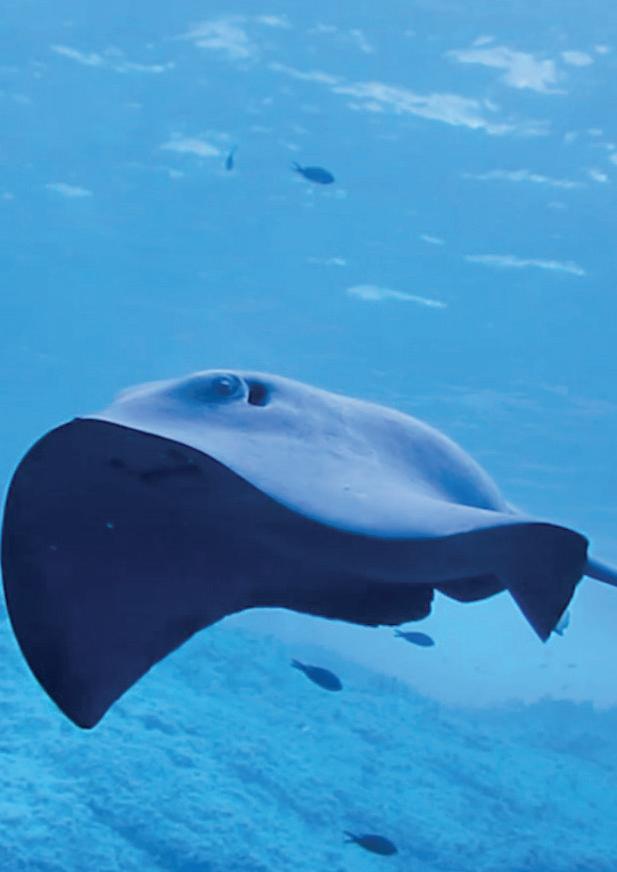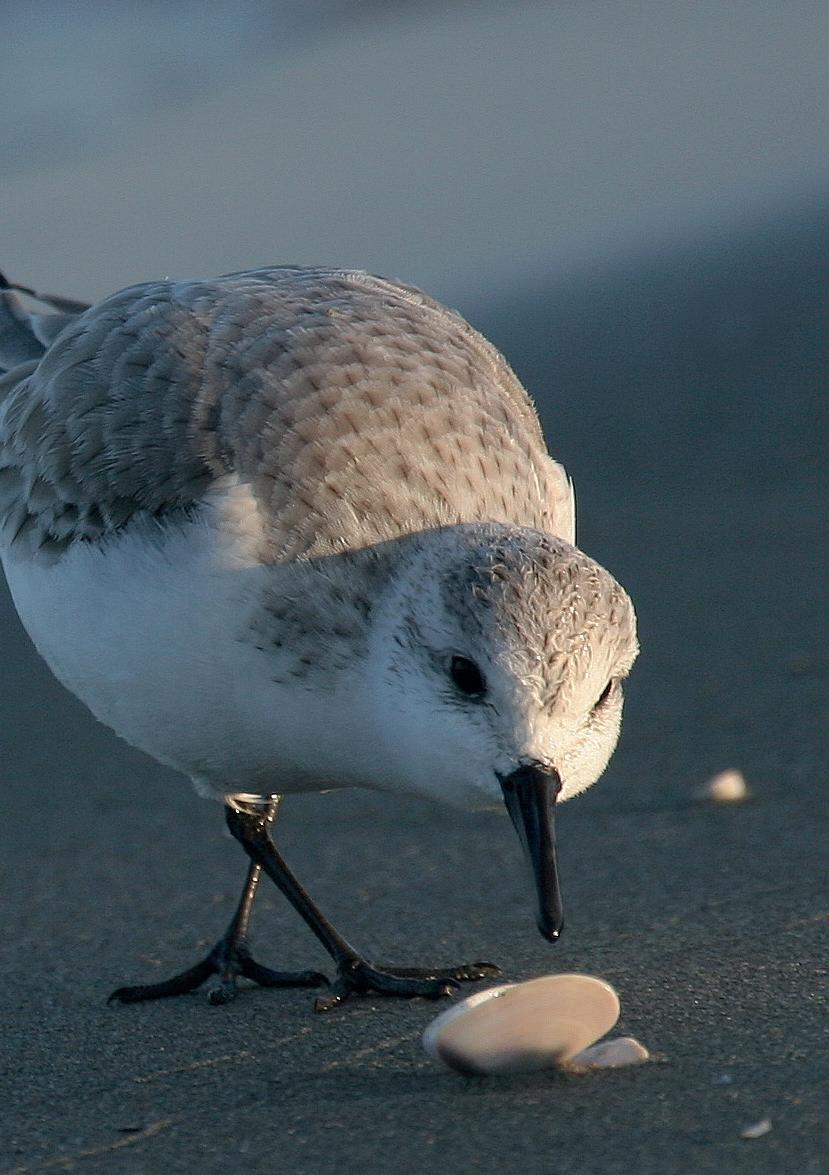
13 minute read
and Marine Protected Areas
2.
Open challenges for governance of Mediterranean coastal and Marine Protected Areas
Advertisement
2.1 Marine governance in action: criticalities, solutions and capacity building
Giorgio Massaro
On the left: Becasseau sanderling. Author: Marc Thibault Marine Protected Areas (MPA) are internationally recognized tools with the main purpose of conservation and restoration of marine biodiversity levels (Agardy et al., 2003). As widely demonstrated, this can take place more effectively when integrated approaches are adopted, making the regulations effective (MPA rule enforcement) (Guidetti el al., 2008), applying a correct management of activities capable of adequately adapting to changes (adaptive management) (Pomeroy et al., 2004) and involving local populations and different types of users (fishermen, tourists, entrepreneurs, citizens,…) in management and governance processes (citizen science and comanagement) ( Guidetti and Claudet, 2010). However, the choice and definition of management models does not appear simple, and this is partly due to the complexity of the contexts in which a MPA is established, many times through processes that have not considered an appropriate analysis of the local context and often underestimating the correct activation and maintenance of stakeholders’ participatory processes (Beunen and de Vries, 2011). Furthermore, as different categories of protected areas are identified on a global level according to the specific objectives and methods of use of the territory, in the Mediterranean area the MPAs, although characterized by environmental conditions however similar, are operating in different socio-economic and governance contexts (Dudley, 2008). The type of management structures varies (individual local authorities, consortia, environmental associations, ...) as well as the functions, as administrative and financial management, control and surveillance, environmental monitoring and others. It is important to set up a strategy and a management system capable of achieving the conservation objectives of marine resources through their sharing, understanding and, if necessary and possible, a participatory redefinition of the same; this in order to establish a set of actions in which the different parties can recognize their own utility and the satisfaction of their needs and rights (Di Franco et al., 2020). The application of participatory methods turns out to be fundamental both to guarantee an adequate level of transparency in the definition of management choices, raising the involvement from simple information activities to co-management experiences, and to face and overcome/settle real territorial conflicts that undermine both the achievement of the conservation objectives, and the socio-economic development in MPAs (Saarman et al., 2013). The identification of participatory approaches formally recognized internationally can therefore allow to overcome any limitations imposed
by some national regulatory systems that do not yet provide for processes of co-management of resources, introducing sharing and dialogue processes to replace the traditional top-down approach. This can also be done through the use of computer and web tools that help every participation level (Vasiliki et al., 2013). Accordingly, it is necessary to act by developing the skills of stakeholders in understanding the functioning mechanisms of MPAs and participation in their governance. Through the analysis and mapping of stakeholders, it is possible to define the specific training needs and build a capacity-building plan focused on the interests and the possible roles and positions that the various subjects can / want to occupy in the management and governance system of the MPA.
2.2 A good practice on governance of coastal wetlands in the Mediterranean: the Handbook
Brian Shipman
[1] medwet.org/ publications/handbookon-governance-ofmediterranean-coastalwetlands/ [2] The Handbook is part of the overarching initiative of the MAVA Foundation ‘Coastal Wetland Action Plan’. Its preparation was initiated by the Priority Actions Programme Regional Activity Centre (PAP/RAC), coordinated and published under its leadership. It was supported by the International Union for Conservation of Nature (IUCN) and the MAVA Foundation for Nature. [3] www.maristanis.org Mediterranean coastal wetlands are amongst the most fragile and threatened ecosystems, but they are declining at an alarming rate. Today’s wetland managers have a complex task, not only have to manage delicate ecosystems, but also reconcile a bewildering array of social, economic and political agendas, from the global to the local - this is governance. The need for good, effective and equitable governance to achieve their preservation is therefore urgent. In 2020 “the Governance of Coastal Wetlands in the Mediterranean – a Handbook1”, along with on-line tools by B. Shipman and Ž. Rajkovi2 (PAP/ RAC, 2019) was published as a practical guide for the governance of coastal wetlands to meet this need. Concise and based on real-world expertise, the Handbook is designed to support hard-pressed managers, officials and advisors. This is the first governance “recipe book” with linked, easy to use, on-line planning tools to help design efficient governance models that reduce conflict and save time. The key messages of the Handbook are: - Governance is about decisions; - Who has power, authority, responsibility to take decisions? - How are those decisions taken? - How effective and efficient are the decisions? - How accountable are the decisionmakers? Governance and management are interrelated phenomena, governance drives the ongoing management, and, in turn management informs governance. Governance is about the long-term - building relationships, community support, and delivering actions. Most importantly, governance is not a short-term project, it is a long-term commitment extending well beyond the typical project lifespan. Four Mediterranean wetlands with radically different forms of governance provided valuable insights and reflections for the preparation of the Handbook: the Oristano Gulf, on the western Sardinian coast in Italy; the Ghar el Melh Lagoon, 30 km southeast of the town of Bizerte in Tunisia; the Lower Delta of the Bojana-Buna River, with its pilot site in Ulcinj Salina, in Montenegro and the Buna River-Velipoje Protected Landscape, in Albania. Useful insight was also provided by the Transboundary ‘Prespa Park’, a protected area including the Prespa Lakes and their surroundings extending over the boundaries of Greece, Albania, and the Republic of North Macedonia. Among these, the particular case of the Oristano Gulf followed, through the Maristanis project3 , a voluntary contract approach: a negotiated, shared and agreed process for implementing a coastal wetland integrated management model via an open and voluntary agreement in which interested parties joined freely. This approach aims at harmonise
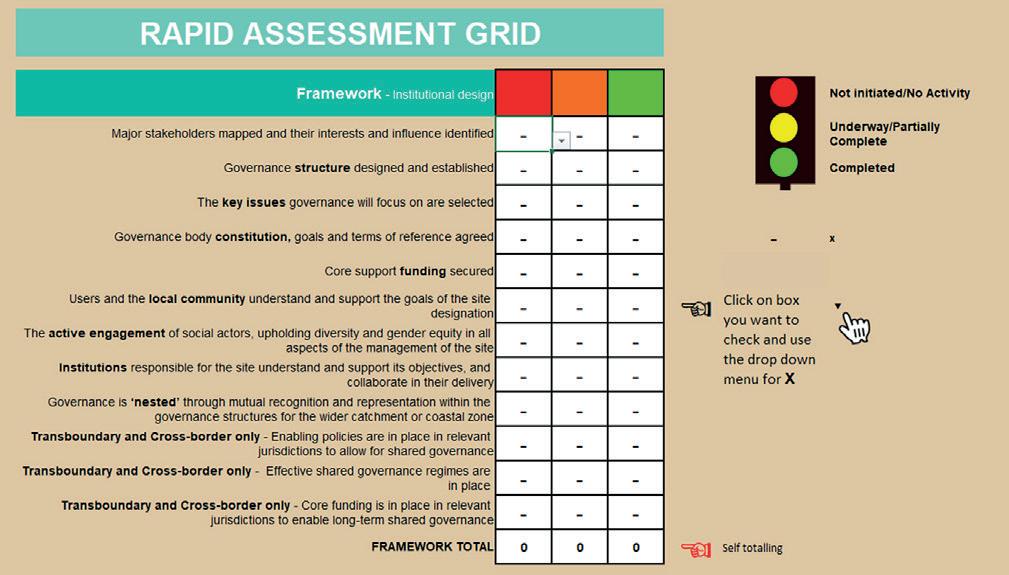
already existing planning tools to solve environmental issues of specific areas, such in the case of the territory of the Oristano Gulf and its wetlands including 11 municipalities. In line with the Maristanis project for coastal wetlands, the Interreg Tune Up project presents a methodology for a very similar governance model, namely that of Environmental Contracts applied to Marine Protected Areas. Despite the MPAs may have different and particular territorial backgrounds compared to wetlands, in some cases they may share the same management and governance problems, as in the case of the transitional zones between sea and land areas (e.g. areas of marine water the depth of which at low tide does not exceed six meters – de facto considered as coastal wetlands as per the definition of Ramsar Convention on Wetlands). In those terms, the voluntary contract approach is a flexible tool adaptable to different local circumstances and territorial backgrounds. Based on the experience from the pilot sites, project team members and interested stakeholders had the opportunity to improve their governance frameworks, and provide some ideas to be shared with other Mediterranean coastal wetlands, via the tips and best practice case studies provided. The key lesson from the four sites is that no one-size-fits-all governance structure or process can hope to fit the complexity of Mediterranean cultures, geographies and political systems. However, there is a need for a simple, universally applicable roadmap. Integrating the principles and practice of Integrated Coastal Zone Management (ICZM), Integrated Water Resources Management (IWRM), and the tools offered by the two relevant conventions: the Ramsar Convention on Wetlands and the Barcelona Convention (UNEP/MAP), the Handbook provides just such a
Figure 2.1 - Rapid assessment grid

Figure 2.2 - Vitality Scorecard roadmap, one that: - reports progress; - builds a shared vision, and plans a way forward; - tests and reviews existing governance arrangements; - helps design and test new governance arrangements.
The roadmap is designed to work on long-established sites or newly designated ones, and across international boundaries. The Handbook and on-line selfassessment tools Using downloadable tools, the guidance of the Handbook provides: 1. A Rapid Assessment Grid - using a widely recognised traffic light system to measure the user’s governance status quo (figure 2.1). 2. A Governance Planner - that allows the user to identify actions, indicators, barriers to progress and priorities. 3. A Vitality Scorecard = uniquely, the Handbook goes beyond a simple tick-box process and meets the challenge of designing excellence into management - excellence defined by the IUCN as vital and adaptive, empowering and inclusive, creative, lively and innovative, and includes that most elusive of qualities – wisdom (Figure 2.2).
Tips & Tricks
Finally, the Handbook contains a plethora of tips and tricks garnered from experienced managers. Such practical tips to make governance effective are provided based on the real-world governance experience to help users design the way forward for the governance of their wetland, to deliver the elusive vitality of governance, and thereby the aid longterm sustainability of the process itself.
2.3 A socio-economic overview of the Mediterranean area
Anna Laura Palazzo
The future socio-economic scenarios relating to the 24 countries bordering the Mediterranean mainly concern two issues. The former addresses the demographic growth of more than 20% of the current 500 million people, especially in the countries of the southern shore; this will lead to increased energy demand and consumption. The latter concerns the geopolitical framework, mainly determined by the interests of the transport giants and terminal companies that compete for market shares in flows between Asia and Europe. The combination of these factors will determine heavy repercussions for the Natural and Social Capital of the Mediterranean area.
Demographic and energy scenarios
With reference to demographic sustainability, the 24 coastal countries already involved in the signing of the Paris Agreements4 have developed through the MEDENER network, which gathers their respective national energy authorities, two alternative energy scenarios, one called "business-as-usual "(CS) and the second one "transition volunteer scenario"(TS) which carries out and reinforces the programs and objectives of the official documents of the States. In the bipartition between countries of the North and the South, the former have started transition paths with a significant use of renewable energies. Here, from 2010 to 2016, energy demand fell by 4%, in relation to the limited demographic growth (+0.5%) and the decrease of in GDP, following the 2008 crisis (-2%). In the same time period, the countries of the South experienced high economic and demographic growth (respectively +6% and +5%), with a corresponding energy demand (+6%) (Figure 2.3). From the first graph emerged that for the Northern countries, the transition scenario envisages a decrease in energy demand (-22%), compatible with forms of energy saving connected to more performing technologies and virtuous practices, while for those of the South, the increase in aggregate demand should be around 55%. The second graphs shows that, compared to the business-as-usual scenario, in the energy transition scenario, compatible with high levels of energy security, there are estimated: i) a significant reduction in primary energy demand (-30%) and final demand (-23%); ii) an increase in the share of renewable energies, mainly solar and wind, in the region's energy mix, to become the leading source of electricity production (+ 27%); iii) a 38% reduction in greenhouse gas emissions; iv) the abandonment of additional fossil sources for a power of 200 GW. With reference to the transition scenario, energy savings for the industrial sector could reach 25% for the entire Mediterranean area, due to the commitments of the main players in the improvement of quality standards and through the
[4] At the Paris Climate Conference (COP21, 2015), 195 countries adopted the first universal and legally binding agreement on the global climate. The agreement defines a global action plan, limiting global warming to below 2 ° C of average temperature increase compared to preindustrial levels.
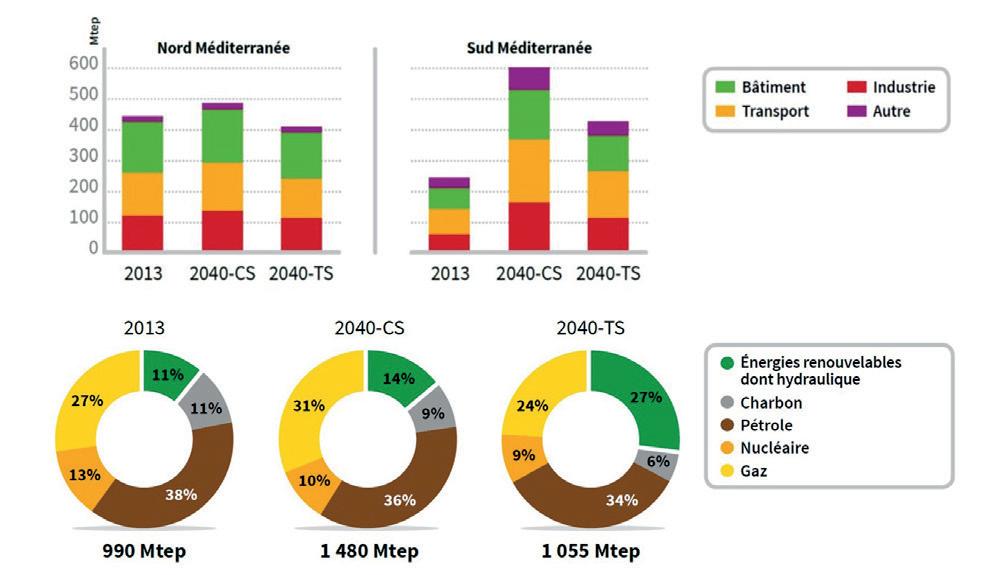
Figure 2.3 - Energetic scenarios in the Mediterranean. 1a. Final energy consumption by sector and by macro-region. 1b. Primary energy consumption in the Mediterranean energy mix. Source: MEDENER/ OME, 2015 www.ademe.fr/sites/ default/files/assets/ documents/vers_ engl_25_oct_bat_web. pdf introduction of cleaner and more efficient technologies; in the transport sector, the estimated energy saving of 21% would refer to various factors, such as the use of more ecological vehicles, and the implementation of integrated models for organization and management of the urban areas. The electricity sector represents a priority in terms of energy saving, being able to reduce the final consumption by over 30%.
The Mediterranean of flows
With reference to the geo-political projections, the Mediterranean space appears as a fragile hinge of maritime traffic between the Atlantic, historic trading area, and the emerging Indo-Pacific area, by non-European decision-making, especially by the so-called BRICS countries (Brazil, Russia, India, China and South Africa). In recent decades there has been an expansion of the major Mediterranean ports with an average annual increase of 21% in the number of containers handled (Figure 2.4). Such is the case of the agreements among Russia and China for the primacy of the logistic network through integrated platforms of regional interest and the exclusive management of Special Economic Zones (SEZs). These areas benefit from bureaucratic and tax regimes in the countries where they are located, due to the reduction of customs duties, the simplification of administrative procedures, easier access and the reduction of costs of some utilities, the relaxation of monetary exchange regulations. The lead actors of such initiatives are seldom the coastal countries or the European Union: among the BRICS countries, China, Russia and South Africa hold together the ambitious organization and management of a service platform, including banking and finance, that favors access to Central Africa from the countries of the southern shore of the Mediterranean. Among the general and thematic institutional networks of the Mediterranean governance, the Union
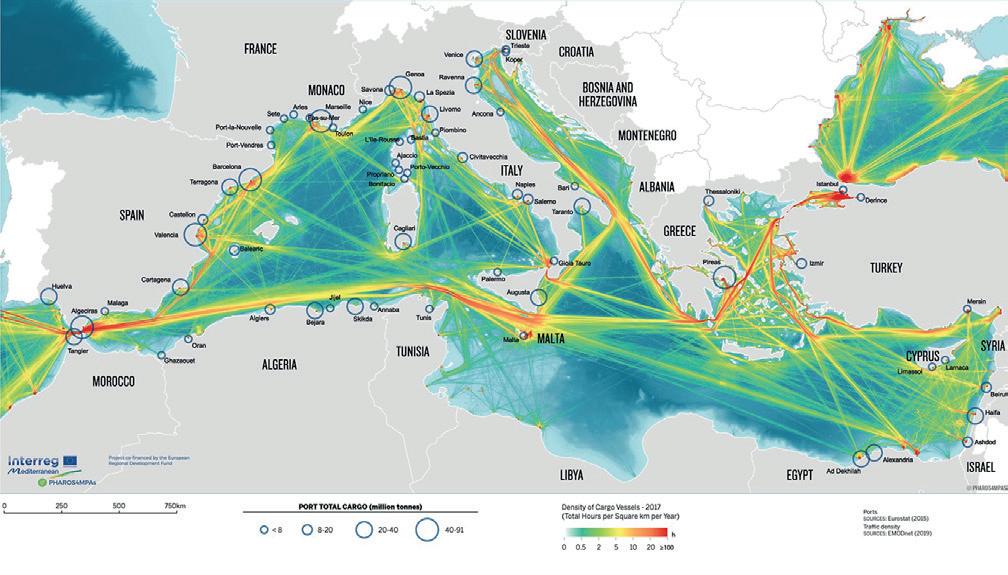
for the Mediterranean (UfM), aiming at stability and integration throughout the region, is also set up for negotiating with global stakeholders. The UfM is a forum for discussion and analysis of regional strategic issues based on the principles of co-ownership, co-decision and shared responsibility between the two shores, with action plans focused on two main factors: (i) favoring human development and promoting sustainable development; (ii) identifying and assisting programs of regional interest in a multi-level governance, following unanimous decisions by the subscribing countries5 .
Conclusions
The Mediterranean leadership is currently in the hands of individual coastal countries and city ports provided with important logistical connections, directly negotiating huge advantages with their counterparts. However, the eclipse of institutional networks of a regional governance able to effect adaptation, learning and reorganization processes in Mediterranean societies, exposes the Natural and Social Capital to high erosion risk.A common agenda should include the participation of the EU and the European countries as well in programs such as restructuring of ports and enhancing logistics, arranging the SEZs, strengthening the participation of 'European macro-regions' in extra-European projects. These federative issues could also include the monitoring and assessment of the commitments underway in the Mediterranean area in implementing the 2030 Agenda. As stated by influential studies, a shared Mediterranean-based political and diplomatic action would lead the United Nations to formally recognize the Mediterranean basin as an area with a precise identity, homogeneous and interconnected albeit complex and fragmented: such acknowledgement would certainly help launch more stable cooperation forms.
Figure 2.4 - Annual density of cargo vessels crossing and/or passing MPAs and other conservation areas of the Mediterranean. Source: WWF [5] The Union for the Mediterranean (UfM) is an intergovernmental organisation bringing together all EU countries and 15 countries of the Southern and Eastern Mediterranean. It was founded in 2008 at the Paris Summit for the Mediterranean to strengthen the Euro-Mediterranean Partnership. The parliamentary assembly is divided into five permanent commissions: politics, security and human rights; economic, financial, social affairs and education; quality of life, exchanges between civil society and culture; women's rights; energy, environment and water. On the right: Albufera de Valencia sealife. Credit: samarucdigital.com
